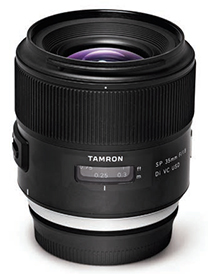 Third party lens manufacturers have recently pumped up their game with improved optics and premium construction. So far, we have noted this in Sigma Art and Sport series lenses. Now Tamron seems to have woken up to the competition with the 35mm f/1.8 and 45mm f/1.8 SP-series lenses. We have the SP35mm f/1.8 Di VC USD on our test bench. Let us see if Tamron can unseat Sigma in the popularity space, although we are not comparing the two lenses side-byside.
Third party lens manufacturers have recently pumped up their game with improved optics and premium construction. So far, we have noted this in Sigma Art and Sport series lenses. Now Tamron seems to have woken up to the competition with the 35mm f/1.8 and 45mm f/1.8 SP-series lenses. We have the SP35mm f/1.8 Di VC USD on our test bench. Let us see if Tamron can unseat Sigma in the popularity space, although we are not comparing the two lenses side-byside.
Design and Build Quality
The Tamron SP35mm f/1.8 is a premium lens and sports a premium look and feel. The outer body is made of metal and engineering plastics. It has a metal mount and a matte- finished metallic ring that provides a classy look. The lens is weather-sealed with a rubber ring that keeps dust and water from reaching the lens flange or sensor. The distance scale is legibly marked with white lettering. The design marks significant difference in quality over most other Tamron lenses. The lens has two buttons, one for Vibration Compensation (VC) and the second for Focus mode. VC provides only On/Off options and Focus modes are Autofocus (AF) and Manual Focus (MF). The lens has a filter size of 67mm and a maximum diameter of 80.4mm. It has a length of 80.8mm for the Canon and 78.3mm for the Nikon model. The lens weighs 480g and 450g for Canon and Nikon respectively.
Key Features
The Tamron 35mm f/1.8 lens is primarily designed for 35mm full frame cameras, but can be used with APS-C sensor cameras. It provides a diagonal angle of view of 63°26’ on full frame and 43°29’ on APS-C format. The lens is constructed with 10 elements in 9 groups including two molded glass aspherical elements which deliver uniform sharpness over the entire field. This also compensates for spherical and chromatic aberrations. In addition to this, the lens uses an LD (Low Dispersion) element along with an XLD (Extra Low Dispersion) element. These elements help deliver crisp and clear images and eliminate colour fringing. The lens employs optical Vibration Compensation (VC) to deliver blur-free images even in low light.
The Tamron 35mm lens uses a 9-bladed diaphragm providing a circular aperture. The lens provides a minimum aperture of f/16. It is available in Canon, Nikon, and Sony mounts. The lens uses an Ultrasonic Silent Drive (USD) focus motor, which is believed to provide faster, more accurate, and silent autofocus. This provides full time manual override even in autofocus mode.
The 35mm lens is coated with eBAND (Extended Bandwidth and Angular-Dependency) and BBAR (Broad-Band Anti-Reflection) antire flection coatings that eliminate flare and ghosting. eBAND is a nano-structured layer coated on the surface of a critical element. This offers higher transmissivity and a significant improvement in anti-reflection characteristics against angular incident rays. This lens delivers exceptionally uniform illumination levels across the image field to avoid non-linear pattern or light fall-off toward corners. The lens has a minimum focussing distance of 0.2m, which is slated to be the best in this category of lenses. The 35mm lens provides a maximum magnification ratio of 1:2.5.
The lens also has a Fluorine coating that provides long-lasting oil and water resistance. This makes it easier to wipe moisture and smudges away. The lens is constructed with weather sealing that prevents moisture from entering the internal mechanisms of the lens, allowing you to shoot outdoors in adverse conditions.
The lens is constructed with weather sealing that prevents moisture from entering the internal mechanisms and the camera body

